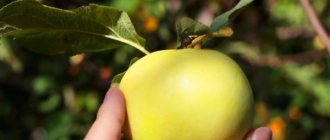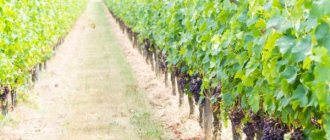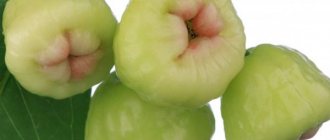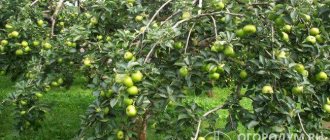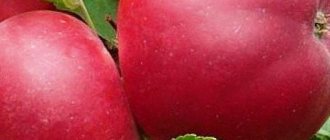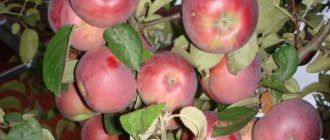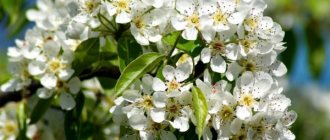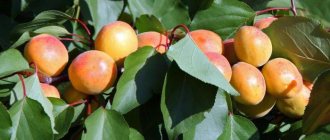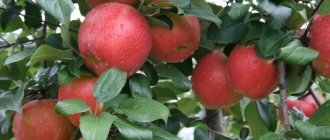Since ancient times, the apple tree has taken its rightful place in our garden plots.
Its fruits have not only excellent taste, but also medicinal properties .
It is believed that the apple tree does not need care.
If you want to grow a healthy, fruit-bearing tree, you should listen to the advice of gardeners. Following these simple rules will allow you to always have an excellent harvest of fruit .
In this article you will see a photo and description of the Korey variety.
Description
The Korey apple tree is one of the best late-winter varieties , with an early fruiting period - 5 years after planting, winter hardiness is average.
Advantages of the variety:
- High yield,
- drought resistance,
- Precociousness,
- Good keeping quality of fruits.
Disadvantages of the variety:
- Weak immunity to scab,
- Shrinking of fruits with a bountiful harvest.
Apple tree blossoms in the southern region begin at the end of April.
Important! This apple tree variety is self-fertile, so it needs pollinators, the best of which are Golden Delicious, Kuban, and Idared.
It is advisable to plant pollinating varieties in close proximity to the Korey apple tree.
The harvest begins at the end of September and continues until the beginning of October.
Fruiting is annual.
Productivity is high - up to 300 c/ha, on weak-growing rootstocks - up to 600 c/ha.
The fruits are distinguished by their high shelf life and transportability; they are stored in a cool room until the end of spring.
Tasting score – 4.5.
Used in natural and processed forms.
Presentation of apples of the Korey variety.
Winter apple varieties
Their main difference from other varieties is their resistance to harsh climates. The harvest is harvested before the onset of severe frosts. Among the characteristic features are a rich aroma, good taste, and no difficulties with transportation. Winter hardiness is a quality that implies the ability to withstand low temperatures for a long period. Fruits obtained from growing winter apple trees do not lose their beneficial properties for a long time. They are often stored until the summer months begin. This makes the taste more intense and the aroma more stable.
Varieties that have this valuable property are no less popular than high-yielding summer and autumn varieties. Experienced gardeners often plant apple trees belonging to different winter varieties. Today, without much difficulty, you can purchase seedlings from both domestic and foreign producers.
Sheep wool is the main product, advantages and disadvantages of sheep farming, overview of breeds and maintenance rules
The imported ones include Golden Delicious, Jonathan, Jonagold and Idared. The latter was the result of selection between two main varieties: Wagner and Jonathan. Its fruits are distinguished by their flat-round shape, large size, glossy tint and light green color.
The list of the most popular includes such domestic varieties as:
Antonovka vulgare
Frost-resistant, tall, not resistant to scab. It begins to bear fruit only at 7-8 years. Ripens at the end of September. Stored until January.
The fruit is round, flattened, green with yellowness, juicy, sweet and sour taste (about 200 g).
Aurora Ural
The tree grows to medium size. The variety was produced for the Volga-Vyatka region. The fruits are oval, about 85 g, yellowish with wide ruddy sides, juicy, wine-sweet taste. Not winter-hardy enough, but shelf life is good (until January).
Moderately resistant to scab.
Aphrodite
Winter-hardy, scab-resistant.
The fruit is medium size (125 g), greenish with a rich raspberry blush, sweet and sour.
Bezhin meadow
Early fruiting, productive, highly resistant to apple tree diseases.
Berkutovskoe
Drought-resistant, winter-hardy.
Not resistant to powdery mildew. Fruit (150 g), with red stripes and yellowish pulp, juicy, sweet and sour.
Bolotovskoe
It is distinguished by high frost resistance, resistance to scab, and keeping quality (mid-February).
Disadvantage: if you are late with cleaning, it quickly crumbles.
Bryanskoe
It begins to bear fruit already in 3-4 years and is winter-hardy.
Not resistant to rot, but resistant to scab. High-yielding, does not fall off, good presentation.
Veteran
Advantages: fruiting for 4-5 years, scab resistance, storage until March, amazing taste and appearance.
Disadvantages – winters medium, rapid leaf fall.
Knight
A large tree with a drooping crown. Frost-resistant, scab-resistant, lasts until May.
Cherry
Dessert, pink and snow-white color. Ripens in early autumn and is stored until January.
Moderately resistant to frost and disease.
Star
Storage until early March. Needs pruning and is resistant to scab.
But may suffer from very low temperatures.
Champion
The tree is compact. Early fruiting in the 3rd year, good annual harvest in the 5th. Winter hardiness, powdery mildew damage is average, scab resistance is high.
Susceptible to other diseases (bacterial burn, bitter pitting). The fruits are large (up to 200 g). Stored in the refrigerator until spring.
Winter striped
Advantages - fruiting for 3-4 years, tasty, beautiful fruits, stored until mid-spring.
Disadvantages - not resistant to scab and severe frosts.
Kuibyshevskoe
A large tree with a conical crown. Winter-hardy, but easily susceptible to disease. The fruit (about 130 g) is yellow with pink sides, stored until the end of winter.
High-yielding variety. When growing winter varieties, it is necessary to take into account several important nuances. To get a good harvest, the gardener will have to regularly fertilize and trim the crown. These measures are included in the complex of energy-saving agricultural technology. This way the fruit gets more nutrients.
additional characteristics
- The trees are medium-sized , moderately growing, reach a height of 5-6 m, the crown is spreading, and in mature trees it is weeping.
- The branches are long , arched, dark gray. The lower branches form an acute angle with the trunk, the upper branches form a straight angle.
- The shoots are slightly pubescent, straight. Fruit formation is mixed, 2-3 apples on two-year-old shoots and last year's growths.
- The leaves are medium- sized, ovoid, glossy, the tip of the leaf blade is slightly curled.
- The fruits are elongated , oblong-conical, and can reach a weight of 120 to 200 g. The color of the skin is yellowish-green; a brown blush appears in bright sun. The pulp is greenish, juicy, sweet, and upon reaching consumer maturity acquires a light melon aroma.
Fruits of the Korey variety on an apple tree branch up to 120-200 g.
Productivity
This variety of apple tree is considered early-bearing - it begins to bear fruit already in the fifth year. Fruiting is annual.
It has a high yield ; in some cases, up to 600 centners can be collected from one hectare, usually up to 300.
Fruits can be harvested at the end of September and until the beginning of October.
Fruit storage is possible until June. Apples can be consumed both fresh and processed.
Transportability is good , high quality fruit marketability.
Reviews
Vadim. “This is my favorite variety with very tasty, sweet apples. in the basement until June . Both adults and children love them. The trees are unpretentious in care, but love watering. I also prune and fertilize annually. The harvest is good.
My family is very happy, all the guests have only positive reviews.”
Marina. “We came across a description and photo on the Internet a long time ago. Korey apples are large, of excellent taste, juicy, crunchy, and smell a little like summer melon . In addition, they are stored all winter. The tree on my plot is old, but it still bears fruit every year and pleases with large and tasty fruits. I recommend this variety of apples to everyone.”
Lily. “I stored Korey apples for the whole winter. At the beginning of spring, they are still juicy and sweet, have not wrinkled, and even begin to smell like melon.
Caring for the Korean apple tree guarantees an annual harvest. Our tree is old and sometimes suffers from scab, especially during rainy summers. But we regularly prune and feed it, and it pays with an excellent harvest, which we harvest every year.”
Harvest and storage
Korey apples are harvested at the end of September, and in some cases at the beginning of October. Fruits can be stored until next summer if storage conditions are provided correctly. To do this, you need to carefully lay out whole apples in layers and place them in a room where there will be about 90% humidity and a temperature of 0°C.
Storing the Korean apple harvest.
A feature of the variety is also its resistance to transportation. During long-term storage and transportation of fruits over long distances, the fruits do not lose their taste and commercial qualities.
Agrotechnical techniques
Caring for the future harvest must begin with planting a seedling. This is true for all fruit trees, but especially for apple trees.
Landing
Planting an apple tree begins with choosing a location.
In order for it to take root well and produce a harvest, it is necessary:
- So that the site is sunny and sheltered from the prevailing winds;
- The depth of groundwater is no higher than 2.0; if it is closer, the tree will become sick and may die;
- If the area is flooded, it is necessary to carry out drainage.
Trees of medium-sized varieties grown on seed rootstock should be planted at a distance of about 3.5 m from each other, with row spacing of about 5 m.
When preparing the planting hole, you should adhere to the following tips:
- Prepare it in advance, 1-1.5 months in advance for autumn planting and in the fall for spring planting;
- The depth of the hole is up to 80 cm, the width is about 90 cm. In the case of fertile soil, the hole can be small, slightly larger than the root ball;
- A soil mixture of the top layer of soil and fertilizer is prepared by adding about 2 buckets of humus, 3 buckets of peat, 1 kg of superphosphate and the same amount of wood ash. If necessary, replace the ash with 160 g of potassium sulfate.
Planting an apple tree in Korea.
Attention! Nitrogen, nitrogen-containing fertilizers and mullein (unrotted manure) are not added to the planting hole, as they reduce the survival rate of the seedling.
During the first growing season after planting the seedling, it is not fed, since everything necessary has been brought into the hole.
Trimming
Pruning a seedling is an important agrotechnical technique that allows you to form the crown of a young tree, strengthen its immunity and winter hardiness, and regulate fruiting.
Pruning of young seedlings begins in the first spring after planting:
- An annual , unbranched seedling is pruned to a height of 80-100 cm;
- For branching annuals and biennial seedlings, branches that form an acute angle with the trunk are removed, the rest, including the central conductor, are shortened by 1/3;
- The central conductor should rise 15-20 cm above the other branches.
Scheme of pruning and forming the crown of an apple tree.
Over the next 3-5 years, pruning is not carried out , as this may delay the entry of the apple tree into the fruiting period. Only diseased branches are removed and in case of very rapid growth, the central conductor is shortened.
Pruning fruit trees.
Mature trees undergo sanitary and rejuvenating pruning, which is aimed at maintaining satisfactory shoot growth strength and ensuring that the crown does not thicken too much.
To do this, use the following techniques:
- Thinning – cutting out entire branches;
- Shortening is cutting off part of a branch.
Heavily thickened crowns are not thinned out immediately, but over several years, so as not to weaken the tree.
Top dressing
Feeding an apple tree is not particularly difficult, but it does require certain knowledge.
First spring feeding . It is applied when the first leaves appear on the trees. , one of the listed nitrogen-containing fertilizers (per tree) is dug into the tree-trunk circle, which runs along the perimeter of the crown
- Urea – up to 0.5 kg;
- A mixture of ammophoska and ammonium nitrate - 30 g each;
- Humus - 4-5 buckets.
In rainy weather, fertilizers can be scattered on the surface of the ground.
Fertilizing the apple tree.
During the flowering period, the second spring feeding of apple trees . Fertilizers are applied in the form of solutions (per 10 liters of water):
- A mixture of superphosphate and potassium sulfate – 100 and 65 g, respectively;
- Chicken manure – 1.5 l;
- Urea – 250 g;
- Slurry - ½ bucket.
Approximately 4 buckets of one of the mixture options are added to each tree.
Foliar summer feeding . It is carried out in mid-July, spraying the trees with a urea solution, and two weeks later - with phosphorus and potassium fertilizers.
Autumn root feeding : buy complex phosphorus-potassium mixtures and apply them to the tree trunk according to the instructions.
Features of planting and care
The health of an apple tree begins with proper planting and selection of seedlings. To do this, you need to choose a place, put useful substances in the hole and take care of your neighbors.
A step-by-step diagram of the correct planting of an apple tree.
Technology
The landing procedure is familiar and quite simple. It is carried out according to a certain scheme:
- Determine the area for planting. It should be well lit, but protected from cold winds.
- If groundwater is close, drainage will be required.
- The planting hole must be prepared in advance: fertile soil and fertilizers must be added to it.
- Plant a young tree, carefully straightening the roots and covering them with soil.
- Water.
Planting can be done according to this algorithm in spring or autumn.
Distance
Between trees of average height it is necessary to maintain a distance of about 3.5 m. And between rows - about 5 m.
Agricultural technology
Among agrotechnical techniques there are standard procedures. It is necessary to carry out correctly and in a timely manner:
- watering;
- protection against diseases;
- spraying against pests;
- crown pruning;
- tree trunk care;
- preparation for winter.
Treating apple trees with vitriol.
Fertilizers are an important condition for the full growth of the Korey apple tree, but they are not applied in the first years of life.
Pruning and crown formation
Pruning is very important. This will help to properly form the crown, regulate the amount of harvest, improve immunity and strengthen the apple tree’s resistance to low temperatures. Pruning is done like this:
- An annual seedling is cut at a height of about a meter to provoke the appearance of side shoots.
- In the second year, branches that form an acute angle are removed, and the central conductor is shortened.
- Then, until the age of five, pruning is stopped.
Pruning must begin again after the apple tree has begun to bear fruit. Then you need to remove all damaged branches, dry ones and those that interfere with the growth of others and thicken the crown. The procedure for proper trimming can be seen in the video.
Pollinator varieties
The Korey apple tree needs to be planted nearby with pollinating varieties. The most suitable for this are Golden Delicious, Idared, Renat Simirenko or Kuban. But any others that bloom at the same time will do.
Apple tree Korey on a low-growing rootstock
Since the middle of the last century, countries involved in fruit production have grown apple trees only on low-growing rootstocks - dwarf and semi-dwarf. This rootstock retains the properties of the mother plant and, at the same time, has a number of advantages:
- Higher yield;
- Early fruiting - bears fruit 2-3 years after planting;
- Thanks to dense planting of trees, it saves space in the garden;
- Trees can be grown in places with close groundwater;
- Characterized by larger and tastier fruits.
The lifespan of dwarfs is 15-20 years, but during this time they will produce significantly more fruits than vigorous trees.
By growing the Korey variety on a low-growing rootstock, you can easily care for the tree and harvest delicious apples.
Advice! When developing a new area with depleted, infertile soil, begin cultivating it several years before planting an orchard. To do this, nitrogen fertilizers (preferably organic) should be added to the soil and dug up.
Diseases and pests
Korean apple trees have good immunity to the disease in the form of brown spot. However, fruit trees of this variety are completely defenseless against such diseases: scab and powdery mildew.
It even happens that no amount of prevention can prevent an apple tree from becoming infected with scab. Then the treatment of the affected tree is carried out using chemicals aimed at destroying the scab causative agent itself - the Vinturia unequal mushroom. Similar chemical components - fungicides - are indicated for the treatment of such fungal infestations.
But before using such drugs, in order to avoid mistakes, you should familiarize yourself with the proposed treatment regimens.
In addition, it is not recommended to use the same drugs to destroy the described fungus, due to the emergence of some resistance to chemicals due to addiction.
The use of industrial products is prohibited on private plots due to the accumulation of poisons in the fruits that are dangerous to human life.
The treatment must be carried out with a special device - a sprayer, for uniform spraying, without causing harm to the trees. Korey apple trees must be processed in calm, windless weather, preferably immediately after it has rained.
Important! Before spraying, parts of trees susceptible to infection must be destroyed by burning them.
To rid apple trees of powdery mildew, you can also use targeted chemicals.
Such chemicals include:
- Copper sulfate.
- Soda ash mixed with laundry soap.
- Products such as Sulfaride and Bayleton.
During the spraying process, gardeners are recommended to use special equipment for personal protection.
For amateur gardeners for whom the use of chemicals is unacceptable, methods from traditional methods of treatment are recommended in the fight against powdery mildew.
A component of this therapy is manure. For processing, a mixture is prepared from 1/3 of a bucket of manure filled with water. A similar solution is infused for about three days, with periodic stirring. Then the mixture is filtered and supplemented with water (1/10).
Important! Spraying must be carried out at sunset to avoid burns to the apple tree.
In addition to diseases, rodents pose a danger to apple trees - mice, bunnies, which love to feast on the bark of these trees. You can scare off such pests with the help of spruce branches - you simply need to surround the apple trees growing on the site with them.
The above-mentioned methods of preventing the treatment of apple trees, as well as saving them from rodents, are effective and simply necessary for the safety of the harvest and the life of fruit trees.
